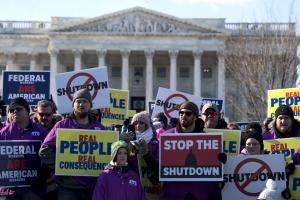Jan. 12 (UPI) — The partial government shutdown entered its 22nd day Saturday, making it the longest closure in U.S. history — a milestone most members of Congress observed on the way back to their home states for a week.
The shutdown surpassed the previous record closure of 21 days, which began Dec. 16, 1995, under the administration of President Bill Clinton. This is the third shutdown under President Donald Trump, though the others — two days starting Jan. 20 and one day on Feb. 9 — were much shorter.
And with Congress’ departure from Washington, D.C., for a week back in their home states, there doesn’t appear to be an end in sight for the shutdown.
The impasse centers around $5.7 billion Trump wants to fund a physical wall along the U.S.-Mexico border. The House and Senate passed a new stopgap funding bill without the wall money he sought by Dec. 21, but the president refused to sign the legislation.
The newly Democrat-controlled House is refusing to add the funding into its legislation. This week, it passed a series of bills funding individual departments and agencies of the government, including Transportation, Housing and Urban Development, Agriculture and Food and Drug Administration.
The Republican-controlled Senate was not expected to pass the legislation.
On Saturday, Trump called on Democrats to return to Washington, D.C., to solve the dispute and reopen the government.
“Democrats should come back to Washington and work to end the Shutdown, while at the same time ending the horrible humanitarian crisis at our Southern Border. I am in the White House waiting for you!” he tweeted.
The shutdown has left 800,000 federal employees on furlough or working without pay. They missed their first paychecks Friday and thousands began applying for unemployment. Trump promised to sign legislation passed by Congress to provide back pay to some 800,000 federal employees out of work because of the partial shutdown.
Meanwhile, the Trump administration this week agreed to keep funding food stamp benefits, but recipients will end up receiving next month’s funds by Jan. 20. That’s weeks earlier than normal, Politico reported.
Representatives from grocery retailers said they’re preparing for an unusually early onslaught of people using some $4.8 billion of benefits in the Supplemental Nutrition Assistance Program.
“We don’t know of any time this has ever happened,” said Hannah Walker, senior director of technology and nutrition policy at the Food Marketing Institute.

COMMENTS
Please let us know if you're having issues with commenting.